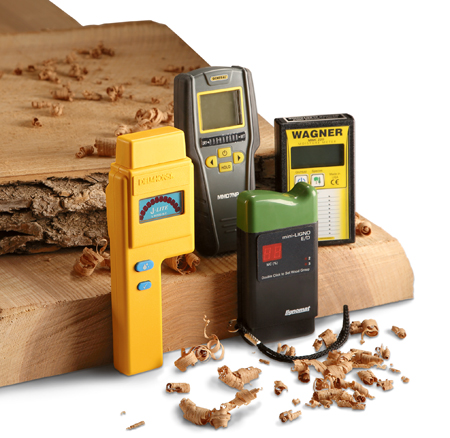
The moisture content of the wood you use to build projects is an important consideration. The moisture content of wood that will be used to build furniture projects should be dried to approximately 6- to 8-percent moisture level in most parts of the United States. A moisture meter is the best tool for measuring moisture levels in wood. As is the case with any tool in your shop, a moisture meter will do you no good if you do not use it correctly.
Here are 10 tips from Wagner Moisture Meters to help you get the most accurate readings from your moisture meter.
1. Wipe Off Standing Water
Before taking wood moisture readings, wipe off any standing or visible water and allow the surface to dry for 60 seconds or more. Standing or visible water always results in inaccurate readings, regardless of the meter type. For example, pin moisture meters with non-insulated pins give highly exaggerated readings when the wood surface is wet. Also, be aware that if water soaks into the wood, it will give a higher MC reading.
2. Is Your Moisture Meter the Right One?
Use the proper meter for the job. If you are working with an exotic wood species, your meter will need a meter with an extended SG range, such as the Wagner MMC220. If you require extended data collection capabilities for quality control, the Wagner MMI1100 offers data analysis functions as well. The right meter for the job will save you time and potential trouble down the road.
3. Consider the Subfloor
If you are measuring moisture content levels in installed flooring, the meter will probably pick up moisture in the subfloor. If the subfloor is made of wood products, this probably won’t skew the readings, but concrete will give a higher reading.
4. Beware of Metal
Never check the moisture content of a piece of wood lying on a metal table. Instead, hold it in the air to take a reading. The reason: Moisture meters are sensitive to anything conductive. Thus, taking a reading on a metal table or near any metal objects such as nails, staples, or metal studs renders the moisture meter ineffective, resulting in a false reading.
5. Don’t Be a Klutz!
Be careful with your meter. Many moisture meters are calibrated at the factory, and will probably never need recalibrating. However, if you drop your meter, or it is accidentally submerged, it could be damaged. You should keep it on your belt loop in the provided carrying case for protection.
6. Keep Fresh Batteries on Hand
Moisture meters do not draw a lot of power, so the batteries will have a long life. It is still a good idea to keep spare batteries with your meter. A quick switch of batteries on the jobsite will make a big difference in time-on-task.
7. Don’t Forget Your Manual
Keep the manuals handy. In addition to the operation manual, the Wagner moisture meter comes with another very useful manual that tells you the specific gravities for each wood you deal with. Be sure to check your manual to get the most from your meter. Both manuals fit nicely next to your meter in the protective carrying case.
8. Keep Your Meter Dry
Be sure there is no condensation on the sensing plate of your moisture meter. Just as the surface you are measuring should be free of visible moisture, the sensing plate should be clear as well.
9. Consider Your Wood Materials
Moisture meters can be used to measure moisture content levels in plywood and OSB, but it may require using a special setting to get the best reading. If your meter has a material selection option, make sure you set your moisture meter to read the material you are testing.
10. Make good contact
Pinless meters require about three pounds of pressure is ideal for a good reading. Pin-style meters must be pressed firmly into the wood until the pins reach the designated reading depth. Be careful not to bend of break pins when pressing them into hard wood.
There you have it–10 ways to get the most from your moisture meter. These pointers will help you use your meter trouble-free for years to come.





